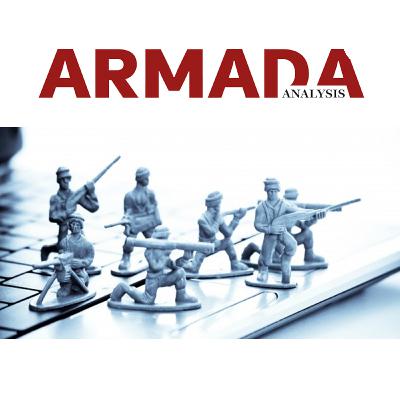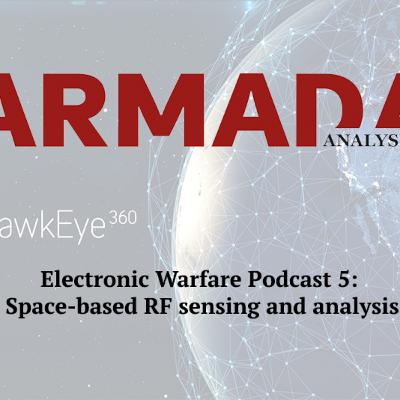Discover Armada Analysis - Podcasts
Armada Analysis - Podcasts

60 Episodes
Reverse
We are delighted to launch Armada’s new series of Military Communications podcasts. In our first episode we dive into the world of Multiple-In, Multiple-Out radio.
Better known as MIMO, this innovative tactical communications technology is making its presence felt in the defence sector. However, you may be unaware of MIMO and how it operates? Jack Moore, vice president of business development for US special operations command and the US Army at Persistent Systems explains how this technology works. Persistent Systems is a leader in MIMO technology for the military and civilian markets.
Revolution is in the air in the Asia-Pacific as defence industrial sectors in the region change and adapt to new strategic realities.
In our latest Armada Electronic Warfare Podcast we catch up with Tate Nurkin, non-resident senior fellow with Forward Defence at the at the Brent Scowcroft Centre for Strategy and Security of the Atlantic Council. Mr. Nurkin recently authored a publication entitled The Five Revolutions: Examining Defence Innovation in the Indo-Pacific Region. This report, which is sponsored by Thales, examines how technological change is affecting the defence-industrial domain in the region, including in the electronic warfare sector. It employs Mr. Nurkin’s ‘Four Revolutions’ framework which he developed as a mechanism to understand and interpret dimensions of modern conflict and military competition.
The ever-present threat of MANPADS attacks on civil aircraft continues to concentrate minds around the world and is the subject of our latest Armada EW podcast.
Since 1978 293 people have lost their lives in during attacks on civilian aircraft executed by Man-Portable Air Defence Systems. Bird Aerosystems produces self-defence equipment designed to protect civilian and military aircraft against these threats. Mr. Mazor shares his thoughts on the trajectory of the civilian counter-MANPADS market, its drivers and restraints in our latest Armada International Electronic Warfare podcast.
Armada International and Asian Military Review Editor-in-Chief Andrew Drwiega talks with Shaun Schaper, Cobham’s engineering specialist, about how an issue called rotor shadowing led Schaper to co-develop a new service called SB-Helo X-Stream, which enables satcom to operate effectively through the rotor disc of a helicopter.
As the electromagnetic spectrum becomes more congested and contested so the EW practitioner’s work increases.
Human factors play a key role in Electronic Warfare (EW) but how do we empower EW practitioners to meet today’s and tomorrow’s challenges? How do the tasks of today’s EW practitioners differ from those of yesterday? What tools do today’s and tomorrow’s practitioners need to meet contemporary and future threats? To discuss these important subjects Armada’s EW Podcast chats to Dave Devine and Phil Guy of Mellori Solutions, a leading Australian EW company.
A recent article contained a startling revelation that US FARRAH satellites provided SIGINT to British forces during the Falklands War.
Taking its name from film and television icon Farrah Fawcett, America’s FARRAH Signals Intelligence (SIGINT) satellites were launched from 1982. That same year, the UK deployed forces to the South Atlantic to liberate the Falkland Islands from Argentine control following their invasion on 2nd April.
The article by space expert Dwayne Day revealed these satellites had provided SIGINT to the British military during the Falklands War. Mr. Day tells us more about this extraordinary revelation in our latest Armada Electronic Warfare Podcast.
Electronic Warfare has a new foe in the guise of the Covid-19 with microwaves harnessed as an effective tool to kill the virus.
Elettronica has developed the E4Shield virus inactivation system which is effective against Covid-19 and several other pathogens.
In our latest Electronic Warfare Podcast we chat to Simone Astiaso, Elettronica’s vice president of engineering and operations, about this new technology and its potential.
Cyber threats and attacks are staples of the evening news, yet how cyber warfare supports conventional military operations is less discussed.
The ongoing war in Ukraine has placed cyber warfare firmly on the agenda. A new book by Daniel Moore called Offensive Cyber Operations: Understanding Intangible Warfare is helping us understand cyber operations.
In our latest Electronic Warfare Podcast he talks about the relationship between cyber warfare and military operations, and reflects on Russian cyber operations in Ukraine.
In our latest Electronic Warfare podcast, we catch up with John Longhurst, CEO of TangentLink, to talk about this year’s forthcoming EW Live event.
As previously, this year’s event will be held in the city of Tartu, southern Estonia. EW Live will run from 19th to 22nd September. The event will include live demonstrations, an exhibition and conference. More information regarding the event can be found on TangentLink’s webpage.
The dangers of the electromagnetic pulse are back on the agenda, fortunately, technology is helping to mitigate this threat.
Russia’s invasion of Ukraine in late February and the accompanying nuclear sabre-rattling of her president Vladimir Putin is refocusing attention on the Electromagnetic Pulse (EMP). The EMP is a potentially devastating surge of electricity accompanying a nuclear explosion. It can wreck unshielded electronics and electrical systems. Meanwhile, the nuclear ambitions of the Democratic People’s Republic of Korea and the Islamic Republic of Iran also bring the EMP threat into stark relief.
In our latest Armada International Electronic Warfare Podcast we discuss the EMP, how it is generated and steps that can be taken to reduce its effects. Our guests are electromagnetic pulse experts Davidson Scott of Emag Associates and Brad Face of The Face Companies.
The United States and Soviet Union poured billions of dollars into signals intelligence satellites during the Cold War.
These spacecraft were an invulnerable and invaluable means of collecting signals intelligence from their rivals.
Yet much of their work was in secret. Today, three decades on from the end of the Cold War, we are starting to learn more about the work of these satellites as documents are declassified and experts share their stories.
In our latest Electronic Warfare Podcast, we chat to Dr. Dwayne Day, a space historian who has written extensively on Cold War space SIGINT gathering.
Chinese electronic warfare is an enigmatic subject. Important new research sheds light on how the People’s Liberation Army’s land forces see EW.
Sam Cranny-Evans is a research analyst at London’s Royal United Services Institute. He recently published some interesting new research on People’s Liberation Army (PLA) land forces electronic warfare. We catch up with with Mr. Cranny-Evans in our latest Armada EW podcast. We talk about the PLA’s EW doctrine and posture, and the importance of electronic warfare to the Chinese way of war. Mr. Cranny-Evans’ research can be found here.
In our latest podcast we chat to Norm Wade, author of Cyberspace Operations and Electronic Warfare, and owner of The Lightning Press.
The Armada postbox was recently graced with the arrival of Norm Wade’s Cyberspace Operations and Electronic Warfare book. Published by The Lightning Press, of which Mr. Wade is the owner, the book is an excellent primer on these two facets of war.
Clear, concise and augmented with excellent diagrams and graphics, the book is an indispensable addition to the bookshelves of anyone with an interest in electronic and cyber warfare. The work is available both as an ebook and a paper copy. To learn more, and to order your copy, visit https://www.thelightningpress.com/smartbooks/cyberspace-operations-smartbook/
The RV Jones Institute is working hard to foster excellence in electromagnetic spectrum operations.
The institute takes its name from Dr. Reginald Jones, the assistant director of intelligence for science at the UK’s Air Ministry during the Second World War.
In this edition of Armada International’s Electronic Warfare podcast we catch up with Melinda and Steve Tourangeau. Ms. Tourangeau is the chair of the institute’s board of directors and the institute’s executive director, while Mr. Tourangeau is the institute’s dean. They talk to us about the organisation’s important work and how members of the electromagnetic spectrum operations community can get involved.
The EMSOpedia is a welcome edition to the canon of electromagnetic support operations literature. It is the subject of our latest Armada EW podcast.
Electronic warfare is notorious for its complex lexicon. As part of its 70th birthday celebrations Elettronica has developed the EMSOpedia (Electromagnetic Support Operations Encyclopedia). This valuable online resource is a one-stop shop for clear and concise definitions of electronic warfare terminology.
In our latest EW podcast we catch up with Daniela Pistoia, Elettronica’s corporate chief scientist, and head of the EMSOpedia’s scientific committee. She tells us about the EMSOpedia’s scope and how members of the EW community can get involved with the project.
A new authoritative report on Russia’s Western Military District gives useful insight on the air defence posture of this robustly defended region.
In our latest Armada EW Podcast we chat to defence analyst and director of Rochan Consulting Konrad Muzyka.
An expert on the Russian military, his new report entitled Russia’s Forces in the Western Military District (WMD) provides a much needed, detailed analysis of Russia’s military capabilities in the WMD. Of particular interest is the district’s air defence posture.
Mr. Muzyka sheds some valuable light on these important, but often misunderstood, capabilities.
In our latest Armada Electronic Warfare Podcast we catch up with Anthony Nigara of L3Harris to discuss how multifunction EW can help Multi-Domain Operations.
Descriptions differ but broadly speaking Armada defines Multi-Domain Operations, known as ‘MDO’ in Pentagon parlance, as integrated operations with sea, land, air and space forces at the tactical, operational and strategic levels enhanced by the integration of personnel, sensors and platforms for the rapid sharing of data.
This integration is intended to allow friendly forces to navigate the famous OODA (Observe, Orient, Decide and Act) loop of strategist Colonel John Boyd at a quicker pace than one’s adversary.
In our latest Armada EW Podcast, we chat to Anthony Nigara, vice president of strategy and business development in L3Harris’ space and airborne systems division. He shares his views on multifunction electronic warfare and what it can contribute to MDO.
The Foxbat was one of the most feared and enigmatic aircraft of the Cold War. We chat to Mike Guardia, author of the new book Foxbat Tales: The MiG-25 in Combat about the aircraft’s innovative radar.
The MiG-25 (NATO reporting name Foxbat) combat aircraft first graced the skies in March 1964, entering service with the Soviet Air Force in 1970. Reaching top speeds of almost Mach Three (1,600 knots/3,000 kilometres-per-hour), the MiG-25 was a potent interceptor and reconnaissance aircraft.
For the Foxbat, speed was life. It had little in the way of self-protection, but it did have a mysterious radar under the nose. The Smerch series transmitted on an X-band frequency of 9.993 gigahertz/GHz, but had a secret dual band capability allowing the radar to also transmit on a Ku-band frequency of 14.9GHz.
In our latest Armada EW Podcast Mr. Guardia reveals what made the Smerch radar special, and how the West unravelled its secrets.
Multi Domain Operations is a phrase thrown around with abandon, but just what does it mean? We talk to Dr. Bill Conley, Mercury Systems’ chief technology officer to find out.
Is MDO just a the latest series of buzzwords or a decisive paradigm shift? The US Department of Defence defines MDO as the rapid and continuous integration of all warfare domains. What does this mean for soldiers, and how is MDO becoming a reality?
Space-based RF sensing and analysis is democratising thanks to the influence of the private sector, no longer solely the domain of those nations rich or ambitious enough to retain such capabilities.
We talk to John Serafini, CEO of Hawkeye 360 about commercial Radio Frequency (RF) collection and RF data analytics, and hear his perspectives on how this industry is developing, its customer base, and how these services my evolve in the future.







